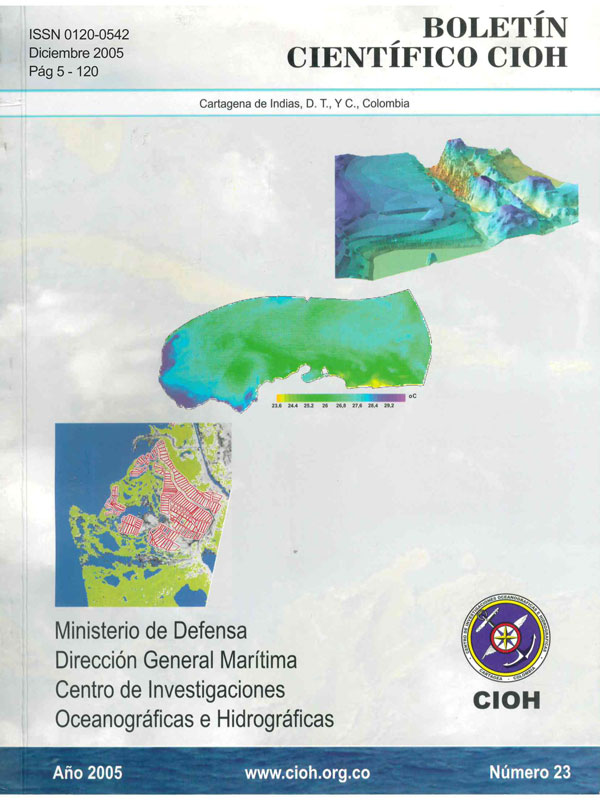Hidrodinámica y distribución de coliformes en el Golfo de Urabá
DOI:
https://doi.org/10.26640/22159045.140Keywords:
Pathogenic micro flora, coli forms, hydrodynamic model, Golfo de UrabáAbstract
Fecal coli forms were observed by CORPOURABÁ in distinct seasons of the year in the Golfo de Urabá, in places relatively far from possible costal sources, having into consideration the degradation rate for pathogenic micro flora that is order of hours. The objective of this paper was to determinate the scales of coli forms pollution extension with the origin in point sources in the principal rivers and urban zone. With the aim of studying coli form dynamics in the gulf, a hydrodynamic model ECOMSED was applied. The substance transport was simulated as well in lagrangian as in eulerian systems. With the first one, spatial dispersion from each one of the sources was identified; with the second, resulted contamination patterns were established for different climate conditions.Downloads
References
Arsitizábal O., M. Betancourt y C. Vásquez(1990). Erosión y sedimentación de la línea de costa entre Turbo y Necoclí, Tesis (Geología), U. de EAFIT, Medellín, 345 p.
Benavides J. Q. (2000). Condiciones meteorológicas y oceanográficas del Golfo de Urabá, Informe técnico, Acuerdo 002 CIOH-EAFIT.
Blumberg, A. F. y G. L. Mellor (1987). A Description of a Three-Dimensional Coastal Ocean Circulation Model, Three-Dimensional Coastal Ocean Models, N. Heaps, Ed., AGU, pp. 1-16.
Chevillot P. y A. Molina (1989). Estudio geológico e hidrológico del Golfo de Urabá, Informe final CIOH, Cartagena.
CIOH (1991a). Circulación de las aguas del Golfo de Urabá aplicando la percepción remota, Informe CIOH, Dic. 1991, 16 p.
CIOH (1991b). Condiciones generales climáticas oceanográficas y geomorfológicas. Golfo de Urabá, Informe final CIOH, Anexo D. Octubre 1991, 20 p.
CIOH (1993). Estudio hidrodinámico delGolfo de Urabá, Informe final CIOH, Junio1993, 68 p.
Cotero E. F. y J. F. Gómez Velásquez (1996), Evolución de la línea de costa del litoral antioqueño. Aspectos geomorfológicos. Sector: río Necoclí – Turbo, CORPOURABA, Apartadó, 118 p.
Franco J. V. (1992). Geomorfología y aspectos erosivos del litoral Caribe colombiano, sector Punta Caribana – Boca Tarena, INGEOMINAS, Cartagena, 48 p.
Municipio de Turbo (2000), Plan de Ordenamiento Territorial (POT), Libro I: Diagnóstico por componentes.
Lonin, S. A. (2004). Empleo de los datos de la NOAA-NODC-WOA en el modelo hidrodinámico del Caribe, Boletín Científico CIOH, (22), pp. 45-55.
Lonin, S. A., C. A. Parra, C. A. Andrade, Yv.-F. Thomas (2004), Patrones de la pluma turbia del Canal del Dique en la Bahía de Cartagena, Boletín Científico CIOH, (22), pp.77-89.
O.E.A. (1978). Proyecto Darién: Estudio para la orientación del desarrollo integral de la región del Darién colombiano, Medellín, 171p.
Roux, H. y D. Dartus (2005). Parameter identification using optimization techniques in open-channel inverse problem, Journal of Hydraulic Research, 43, (3), pp. 311-320.
Sánchez, H. et al. (1990). Nuevos Parques Nacionales de Colombia, INDERENA, Primera edición, Bogotá, 20 p.
Tuchkovenko, Yu. S. y S. R. Rondón (2002), Estudio de Comportamiento de la Contaminación Bacteriana en la Bahía de Cartagena. Boletín Científico del CIOH, (20),pp. 56-67.
Zapata, L. (1998). Evaluación de zonas de erosión críticas en el litoral Caribe Antioqueño. Informe final. Facultad de Minas. U. Nal, Sede Medellín, 190 p.
Downloads
Published
Issue
Section
License
Attribution — You must give appropriate credit, provide a link to the license, and indicate if changes were made. You may do so in any reasonable manner, but not in any way that suggests the licensor endorses you or your use.
NonCommercial — You may not use the material for commercial purposes.
NoDerivatives — If you remix, transform, or build upon the material, you may not distribute the modified material.
No additional restrictions — You may not apply legal terms or technological measures that legally restrict others from doing anything the license permits.



